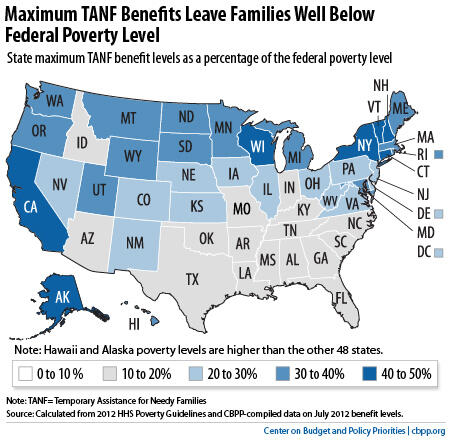BEYOND THE NUMBERS
Cash assistance for the nation’s poorest families with children fell again in purchasing power in 2012, we detail in our annual update of state benefit levels under the Temporary Assistance for Needy Families (TANF) program. Most states left their benefit levels unchanged last year, so benefits continued to erode by inflation.
In 37 states, and after adjusting for inflation, benefits are now at least 20 percent below their levels of 1996 — the year policymakers created TANF.
For all states, as of July 1, 2012, benefits for a family of three with no other cash income were below half of the federal poverty line, measured as a share of the Department of Health and Human Services poverty guidelines for 2012 (see map). Benefits were below 30 percent of the poverty line in the majority of states.

On the other hand, no states cut benefit levels in 2012, and a few took the opportunity to increase the benefit level or to follow through on past commitments to modestly raise benefits or adjust them for inflation. TANF benefits increased, in nominal dollars, in New York, Ohio, South Dakota, Texas, and Wyoming.
TANF provides a safety net to relatively few poor families: in 2011, just 27 families received TANF benefits for every 100 poor families, down from 68 families receiving TANF for every 100 in poverty in 1996. But for the families that participate in the program, it often is their only source of support and without it, they would have no cash income to meet their basic needs.
It’s time for states to halt the erosion of TANF benefits and slowly regain some of the purchasing power that they’ve lost over the past 16 years.
Click here to read the full paper.
